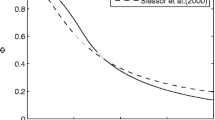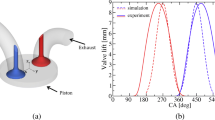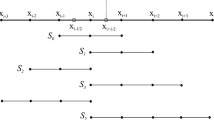Abstract
The response of homogeneous turbulence to rapid mean-flow compression in idealized internal combustion engines and rapid compression machines is examined using a hierarchy of closure models for the Reynolds stress anisotropy. This hierarchy is based on a Reynolds stress anisotropy transport equation that is modeled from the exact transport equation for the anisotropy. The hierarchy of models includes a recently-developed non-equilibrium model, which is shown to be in good agreement with more computationally-complex fully differential models. Using this hierarchical approach, the flow physics addressed by each closure is identified and closure accuracy is shown to depend on the degree to which non-equilibrium turbulent flow effects are captured. We examine the evolution of the turbulence kinetic energy, Reynolds stresses, and anisotropy as a function of the degree of non-equilibrium in the flow, which is parameterized by the ratio of characteristic turbulence and mean-flow deformation time scales. By comparing model results to results obtained from rapid distortion theory and higher level closures, prescriptions are provided for the applicability of different closure models based on the magnitude of the non-equilibrium parameter. The theoretical analysis is complemented by comparisons of simulation results with previously established direct numerical simulations for a one-dimensional compression. Finally, we connect these prescriptions with experimental measurements of turbulent and mean-flow time scales for internal combustion engines operating at realistic conditions.
Similar content being viewed by others
References
Batchelor, G.K., Proudman, I.: The effect of rapid distortion of a fluid in turbulent motion. Q. J. Appl. Math. 7, 83–103 (1954)
Hunt, J.C.R.: A review of the theory of rapidly distorted turbulent flows and its applications. Fluid Dyn. Trans. 9, 121–152 (1977)
Hunt, J.C.R., Carruthers, D.J.: Rapid distortion theory and the ‘problems’ of turbulence. J. Fluid Mech. 212, 497–532 (1990)
Durbin, P.A., Pettersson, B. A. R.: Statistical Theory and Modeling for Turbulent Flows. Wiley (2001)
Jacquin, L, Cambon, C., Blin, E.: Turbulence amplification by a shock wave and rapid distortion theory. Phys. Fluids A 5(2539–2550) (1993)
Coleman, G.N., Mansour, N.N.: Modeling the rapid spherical compression of isotropic turbulence. Phys. Fluids A 3, 2255–2259 (1991)
Durbin, P.A., Zeman, O.: Rapid distortion theory for homogeneous compressed turbulence with application to modelling. J. Fluid Mech. 242, 349–370 (1992)
Blaisdell, G.A., Coleman, G.N., Mansour, N.N.: Rapid distortion theory for compressible homogeneous turbulence under isotropic mean strain. Phys. Fluids 8(2692–2705) (1996)
Yu, H., Girimaji, S. S.: Extension of compressible ideal-gas rapid distortion theory to general mean velocity gradients. Phys. Fluids 19(04), 2007 (1702)
Yu, D., Girimaji, S.S.: Direct numerical simulations of homogeneous turbulence subject to periodic shear. J. Fluid Mech. 566, 117–151 (2006)
Chen, J., Meneveau, C., Katz, J.: Scale interactions of turbulence subjected to a straining-relaxation-destraining cycle. J. Fluid Mech. 562, 123–150 (2006)
Townsend, A.A.: The uniform distortion of homogeneous turbulence. Q. J. Appl. Math. 7, 104–127 (1954)
Keffer, J.F.: The uniform distortion of a turbulent wake. J. Fluid Mech. 22(135–159) (1965)
Tucker, H.J., Reynolds, A.J.: The distortion of turbulence by irrotational plane strain. J. Fluid Mech. 32(657–673) (1968)
Reynolds, A.J., Tucker, H.J.: The distortion of turbulence by general uniform irrotational strain. J. Fluid Mech. 68(673–693) (1975)
Gence, J.N., Mathieu, J.: The return to isotropy of a homogeneous turbulence having been submitted to two successive plane strains. J. Fluid Mech. 101, 555 (1980)
Chen, J., Meneveau, C., Katz, J.: Implication of mismatch between stress and strain-rate in turbulence subjected to rapid straining and destraining on dynamic LES models. J. Fluids Eng. 127, 840–850 (2005)
Liu, S., Katz, J., Menveau, C.: Evolution and modelling of subgrid scales during rapid straining of turbulence. J. Fluid Mech. 387, 281–320 (1999)
Gualtieri, P., Meneveau, C.: Direct numerical simulations of turbulence subjected to a staining and destraining cycle. Phys. Fluids 22(065104) (2010)
Larsson, J., Bermejo-Moreno, I., Lele, S.K: Reynolds- and Mach-number effects in canonical shock-turbulence interaction. J. Fluid Mech. 717, 293–321 (2013)
Wu, C.-T., Ferziger, J.H., Chapman, D.R.: Simulation and modeling of homogeneous, compressed turbulence. Proc. 5th Symp. on Turb. Shear Flows 17, 13–19 (1985)
Le Penven, L., Serre, G.: Homogeneous turbulence submitted to compression, experimental study and modelling. Proc. 9th Symp. on Turb. Shear Flows (1993)
Jakirlić, S., Volkert, J., Pascal, H., Hanjalić, K., Tropea, C.: DNS, experimental and modeling study of axially compressed in-cylinder swirling flow. Int. J. Heat Fluid Flow 21, 627–639 (2000)
Hadžić, I., Hanjalić, K., Laurence, D.: Modeling the response of turbulence subjected to cyclic irrotational strain. Phys. Fluids 13(6), 1739–1747 (2001)
Revell, A.J., Benhamadouche, S., Craft, T., Laurence, D.: A stress-strain lag eddy viscosity model for unsteady mean flow. Int. J. Heat Fluid Flow 27, 821–830 (2006)
Hamlington, P.E., Dahm, W.J.A.: Reynolds stress closure for nonequilibrium effects in turbulent flows. Phys. Fluids 20, 115101 (2008)
Hamlington, P.E., Dahm, W.J.A.: Frequency response of periodically sheared homogeneous turbulence. Phys. Fluids 21, 055107 (2009)
Launder, B.E., Reece, G., Rodi, W.: Progress in the development of a Reynolds stress turbulence closure. J. Fluid Mech. 68, 537–566 (1975)
Speziale, C.G.: Analytical methods for the development of Reynolds-stress closures in turbulence. Annu. Rev. Fluid Mech. 23, 107–157 (1991)
Zhao, F., Asmus, T.W., Assanis, D.N., Dec, J.E., Eng, J.A., Najt, P.M. (eds.) Homogeneous Charge Compression Ignition (HCCI) Engines: Key Research and Development Issues. Society of Autmotive Engineers International, Warrendale, PA (2003)
Dec, J.E.: Advanced compression-ignition engines – understanding the in-cylinder processes. Proc. Comb. Inst. 32, 2727–2742 (2009)
Guibert, P., Keromnes, A., Legros, G.: An experimental investigation of the turbulence effect on the combustion propagation in a rapid compression machine. Flow Turb. Combust. 84(1), 79–95 (2010)
Ihme, M.: On the role of turbulence and compositional fluctuations in rapid compression machines: Autoignition of syngas mixtures. Combust. Flame 159(4), 1592–1604 (2012)
Han, Z., Reitz, R.D.: Turbulence modeling of internal combustion engines using RNG k- ε models. Combust. Sci. Tech. 106, 267–295 (1995)
Bianchi, G.M., Pelloni, P., Zhu, G.-S., Reitz, R. On Non-Equilibrium Turbulence Corrections in Multidimensional HSDI Diesel Engine Computations. SAE Tech. Paper Ser., 2001-01-0997 (2001)
Yang, S. L., Peschke, B. D., Hanjalić, K.: Second-moment closure model for ic engine flow simulation using kiva code. J. Eng. Gas Turb. Power 122, 355–363 (2000)
Yang, S.L., Siow, Y.K., Teo, C.Y., Hanjalić, K.: A KIVA code with Reynolds-stress model for engine flow simulation. Energy 30, 427–445 (2005)
Jakirlic, S., Tropea, C., Hadzić, I., Pascal, H., Hanjalić, K.: Computational Study of Joint Effects of Shear, Compression and Swirl on Flow and Turbulence in a Valveless Piston-Cylinder Assembly. SAE Tech. Paper Ser. 2001-01-1236 (2001)
Amini, B., Zoka, H. M., Khaleghi, H.: A Comparative assessment of variant k−ε models for engine flow applications. IEEE Int. Conf. Comp. Inf. Sci. 2011, 23 (2011). doi:10.1109/ICCIS
Zoka, H.M., Omidvar, A., Khaleghi, H.: On the performance of various Reynolds stress models in resolving non-equilibrium features of turbulent in-cylinder engine flows. Arab J. Sci. Eng. (2012). doi:10.1007/s13369-012-0477-x
Zoka, H. M., Omidvar, A., Khaleghi, H.: A comparative assessment of a compressible Reynolds stress model and some variant k−ε models for engine flow applications. Arab J. Sci. Eng. 37, 1737–1749 (2012)
Speziale, C.G., So, R.M.C: The Handbook of Fluid Dynamics, chapter 14, Turbulence Modeling and Simulation, pp. 14.1–14.111. Springer (1998)
Gatski, T.B., Jongen, T.: Nonlinear eddy viscosity and algebraic stress models for solving complex turbulent flows. Prog. Aero. Sci. 36, 655–682 (2000)
Johansson, A.V.: Engineering turbulence models and their development, with emphasis on explicit algebraic Reynolds stress models. Theories of Turbulence - CISM Courses and Lectures - No. 442, pp. 253–300. Springer (2002)
Pope, S.B: Turbulent Flows. Cambridge University Press (2000)
Kolmogorov, A. N.: The local structure of turbulence in incompressible viscous fluid for very large Reynolds numbers. Dokl. Akad. Nauk SSSR 30, 299–303 (1941)
Rotta, J: Statistische Theorie nichthomogener Turbulenz. Z. für Phys. 129, 547–572 (1951)
Speziale, C.G., Sarkar, S., Gatski, T.B.: Modeling the pressure strain correlation of turbulence: An invariant dynamical systems approach. J. Fluid Mech. 227, 245–272 (1991)
Hanjalić, K.: Advanced turbulence closure models: A view of current status and future prospects. Int. J. Heat Fluid Flow 15(3), 178–203 (1994)
Olsen, M.E., Coakley, T.J.: The lag model, a turbulence model for nonequilibrium flows. AIAA Paper, 2001–2564 (2001)
Launder, B.E., Spalding, D.B.: The numerical computation of turbulent flows. Comput. Meth. Appl. Mech. Eng. 3, 269–289 (1974)
Wilcox, D.C: Turbulence Modeling for CFD, DCW Industries (2000)
Taulbee, D.B.: An improved algebraic Reynolds stress model and corresponding nonlinear stress model. Phys. Fluids A 4(11), 2555–2561 (1992)
Gatski, T.B., Speziale, C.G.: On explicit algebraic stress models for complex turbulent flows. J. Fluid Mech. 254, 59–78 (1993)
Shih, T.H., Zhu, J., Lumley, J.L.: A new Reynolds stress algebraic equation model. Comput. Methods. Appl. Mech. Eng. 125, 287–302 (1995)
Crow, S.C.: Visco-elastic character of fine-grained isotropic turbulence. Phys. Fluids 10(7), 1587–1589 (1967)
Crow, S. C.: Viscoelastic properties of fine-grained incompressible turbulence. J. Fluid Mech. 33, 1–20 (1968)
Shampine, L.F., Reichelt, M.W.: The Matlab ODE suite. SIAM J. Sci. Comput. 18, 1–22 (1997)
Heywood, J.B: Internal combustion engine fundamentals. McGraw Hill (1989)
Liou, T.-M., Santavicca, D. A.: Cycle resolved LDV measurements in a motored IC engine. J. Fluids Eng. 107, 232–240 (1985)
Lancaster, D. R.: Effects of engine variables on turbulence in a spark-ignition engine. SAE Paper 760159, 671–688 (1976)
Hong, C.W., Tarng, S.D.: Direct measurement and computational analysis of turbulence length scales of a motored engine. Exp. Therm. Fluid Sci. 16, 277–285 (1998)
Glover, A.R., Hundleby, G.E., Hadded, O. (1988)
Fraser, R.A., Bracco, R.A.: Cycle-resolved LDV integral length scale measurements investigating clearance height scaling, isotropy, and homogeneity in an I.C. engine, SAE Paper 890615 (1989)
Corcione, F.E., Valention, G.: Turbulence length scale measurements by two-probe-volume LDA technique in a Diesel engine, SAE Paper 902080 (1990)
Ikegami, M., Shioji, M., Nishimoto, K.: Turbulence intensity and spatial integral scale during compression and expansion strokes in a four-cycle reciprocating engine, SAE Paper 870372 (1987)
Obokata, T., Hashimoto, T., Gojuki, S., Karasawa, T., Shiga, S., Kurabayashi, T.: LDA characterization of gas flow in a combustion chamber of a four-stroke S.I. engine, SAE Paper 920519 (1992)
Author information
Authors and Affiliations
Corresponding author
Rights and permissions
About this article
Cite this article
Hamlington, P.E., Ihme, M. Modeling of Non-Equilibrium Homogeneous Turbulence in Rapidly Compressed Flows. Flow Turbulence Combust 93, 93–124 (2014). https://doi.org/10.1007/s10494-014-9535-7
Received:
Accepted:
Published:
Issue Date:
DOI: https://doi.org/10.1007/s10494-014-9535-7




